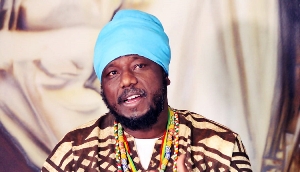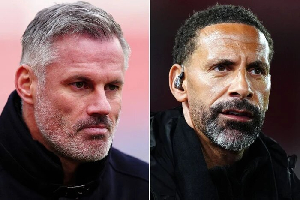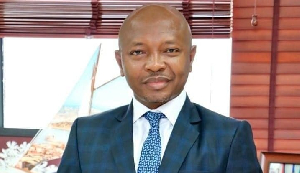By : E. M. N. Ametor-Quarmyne
On February 18th 2015, six days to the 49th anniversary of the great treachery that led to the darkest day in the history of our dear nation, Ghana, the occasion of the sinister overthrow of Osagyefo Dr. Kwame Nkrumah, founder and first President of Ghana, the adherents of the United Party(UP) tradition, better known as the “MATEMEHO” tradition in Ghanaian politics, plan to invade our city of Accra, with red bands around their necks, and empty cans in hand to drown our broad ears in a cacophony of empty noise. They will contribute nothing by way of workable ideas towards solving a nagging national issue, ”DUMSOR”.
The New Patriotic Party, direct descendants of Dr. J. B. Danquah and Kofi Abrefa Busia’s United Party plan to undertake what they call a “Won Gbo”, demonstration in the city of Accra on that day. “Won Gbo” is a Ga phrase which literally translated means we are dying. They attribute the reason for their planned disturbance of our peace of mind to the fact that the country is currently going through a phase of electrical power shortage leading to the rationing of electricity to homes, offices, industries and commercial entities.
While it is true that no facet of Ghanaian social life and sector of the economy is spared by this phenomenon which has become known as “dumsor”, an apt description in AKAN language of the “off and on” nature of the supply of electricity, the questions on the lips and minds of most discerning Ghanaians are; “will the NPP’s demonstration lead to the end of “dumsor”?, and they ask, “what are the New Patriotic Party’s alternatives, they being the largest opposition party, to the plans and efforts being made by the President John Dramani Mahama led Government of the National Democratic Congress, to find a lasting solution to this disturbing perennial problem”, first experienced in the late 1980s and which has persisted intermittently till now?
It is interesting to note that the New Patriotic Party’s response to these deeply searching questions, as articulated by its spokespersons, often, has been that the NPP is not the party in power and that the incumbent NDC Government under President John Dramani Mahama has the mandate of Ghanaians to govern this country, theirs being to draw the attention of government to problems facing the country and not to proffer any solutions. In short, the New Patriotic Party as the largest opposition party, with a fair chance of assuming political power at some distant future, does not have a clue as to how it would find solutions to national problems such as the current power crisis facing the nation. How interesting.
Well, at this point I am sure readers would like to know what the John Mahama Government has done and is doing to assuage this problem of “dumsor”.
Here we go; for readers to have a fairer idea about this current spate of “dumsor”, and to appreciate the problem more clearly, we need to go back to 1966, when through the efforts of Osagyefo Dr. Kwame Nkrumah, our first President, Ghana completed the construction of its present hydroelectric dam at Akosombo in the Eastern region. (It is noteworthy that Dr. K. A. Busia, co-founder of the UP tradition, to which the NPP belongs, vehemently opposed the construction of Akosombo hydroelectric project, including appearing before the U.S. Senate Foreign Relations Committee to urge the USA not to support for the project on the flimsy excuse that DR. Kwame Nkrumah was a Communist and that Ghana would not be able to repay the loan for the project) Then, the total power requirements of the country was 100Megawatts, whilst Akosombo provided us with 600Megawatts of electric power at the time (1,020Megawatts presently). Ghana at the time had plenty of electric power to spare. That was the reason why Dr. Nkrumah had to invite Mr. Edgar Kaisser of the United States of America to establish an alumina smelter in Ghana in order to use the excess power and to help pay for the loan contracted to build the hydroelectric dam. The result was the Volta Aluminum Company(VALCO) at Tema.
It is interesting to note that today, even the power produced from Akosmbo is not enough for Ghana’s needs hence our present predicament of “dumsor”. The demand for power in Ghana has grown steadily to a recorded peak demand of some 1,366Megawatts in the year 2008. As at today, 2015, the peak demand is estimated to have reached 2,300Megawatts. Presently the existing power production or generation capacity including those of the Volta River Authority(VRA), Bui Power Authority and a number of independent power producers exceed this peak demand at 2,845Megawatts. But as was explained by the Minister of Power in his address to the Press on Monday February 2, 2015, due to a number of unfortunate factors, we are in a situation of inadequate power supply. The reason for this precarious situation is simply as a result of the following :
a. Two units of generators(turbines) at Akosmbo cannot be operated while the other four in operation can only be operated at reduced output of 125MW instead of the rated 170MW due to the low level of water in the Akosombo dam.
b. One out of the four units of generators(turbines) at KPONG is out of service for retrofit
c. Bui dam which is sized to run four units of generators(turbines) currently runs only one also due to the low level of water in the dam
d. TAPCO unit2 is limited to 60MW due to high exhaust temperature spread and load tunnel temperature
e. TICO unit2 is down after a system trip whilst unit 1 is limited to 80MW due to high exhaust temperature spread on the unit
f. CENIT plant is down for Hot Gas inspection
g. Half of Sunon Asogli plant is down due to contaminated lube oil.
This explains the reason for the current load shedding exercise which we are experiencing, due to the shedding of 650MW of power at peak periods. There is absolutely nothing that the NDC Government under President John Mahama could do about the low level of water in the Akosombo, Kpong and Bui dams which would enable these facilities to produce at their maximum capacities. As for the other plants operated mostly by independent power producers (IPPs), and which depend on crude oil or liquefied natural gas to fire them, they have been afflicted by various problems as the Minister of Power informed the nation in his address to the media as indicated above.
Under these circumstances the only options left for the Government are to endeavor to return these already existing units to production as quickly as possible in order to shore up the availability of power and to find new sources of power production. Both of these approaches are being pursued vigorously presently already.
In his address to the press, the Minister of Power assured the nation that: ”we are determined to adopt every strategy necessary to bring an end to the load shedding and also to undertake measures to ensure that we continue with our long term vision to ensure that we have adequate, reliable and sustainable energy in the foreseeable future.”
Regarding short term measures to mitigate the present load shedding, the Ministry of Power is currently working on emergency power badges and others to augment current generation by the addition of 1,000Megawatts from the following sources.
1. 250Megawatts project at the Aboadze enclave in the Western Region, where Ghana’s own gas from the Jubilee fields is available through the Ghana Gas project at Atuabo.
2. Two 225Megawatts power ships to be sited offshore Tema and Takoradi. These together will produce 450Megawatts of power (the first of these is scheduled to be ready by the end of the first quarter while the second will be ready at the end of the second quarter)
3. 250Megawatts by General Electric Corporation of the United States of America.
(These together will generate 950Megawatts of power to augment present generation)
Addressing participants at the West African Clean Power and Environment Conference at the Accra International Conference Centre on Thursday February 12, 2015, the Deputy Minister of Power, Mr. John Jinapor announced that “The financial deal for the procurement of two emergency power barges with installed capacity of 450Megawatts (MW) has been concluded with the first barge expected in the country by April,” giving confirmation to the short term plans of Government aimed at resolving this seemingly intractable problem of “dumsor”.
In addition to the above, according to the Minister, “the Ministry of Power in collaboration with the relevant stakeholders have already made significant progress towards the completion and commissioning of the following new projects, which together will add 330Megawatts of power to the national grid.
a. The 220Megawatts Kpone Thermal Power Project(KTPP)
b. The 110Megawatts Tico Expansion Project at Takoradi
(Please note that KPONE near Tema is different from KPONG on the VOLTA river, down stream from Akosombo, where the VRA has a second generation station)
In the medium term, Government is taking steps to add in excess of 3,000Megawatts of power to the country’s generation stock through the following projects :
1. 360Megawatts Sunon Asogli phase 2 of which sod has already been cut
2. 350Megawatts CenPower project of which sod has been cut
3. 360Megawatts Jacobsen project of which Parliamentary approval has been obtained
4. 240Megawatts Amandi Project of which Parliamentary approval has been obtained
5. 1,000Megawatts General Electric Corporation of USA (proposed project of which discussions are ongoing)
6. 1,000Megawatts clean coal project to be pursued by VRA(under consideration)
7. A project to encourage the use of solar in households, and hotels for basic lighting and water heating in order to free grid power for industrial use.
If these are not enough steps taken in the right direction to tackle our power problems, both in the short and in the longer term, then I wonder what else are. Hear the Minister of Power; “the purpose of adding on substantial generation capacity as shown above, is to create the needed reserve margin or redundancy to efficiently and effectively run a power supply system that is robust and resilient enough to meet the country’s ever increasing demands.”
This is strategic thinking and planning aimed at providing a sustainable solution to this constriction in our industrial production and economic development.
These are the elaborate measures put in place by our Government to tackle the perennial problem of power inadequacy in Ghana, which has been a draw back on our forward march to national development. It has well been known, several years back, through studies conducted by the Ghana Energy Commission that the nation’s energy requirements were growing at a rate of some 12 to 15 percent annually, and that there was the need to add on not less than 200to300Megawatts of power annually, if the country is to meet its energy needs adequately.
President Jerry Rawlings frontally confronted this situation when it first occurred in the late 1980s by building the Aboadze thermal plant which provided over 500Megawatts of power with vast potentials to add on.
It is instructive to note that during the whole of the eight years of the NPP’s rule(2001-2009) only 80Megawatts of power was added to Ghana’s energy stock. Even that was provided by a consortium of mining companies in the country.
The above projects lined up by the Government, would no doubt, if successfully pursued and completed, make Ghana the energy hub of the West African Region. The country is well positioned to supply energy to its neighbours as envisaged by President John Mahama. Already, Ghana is supplying power to the Republics of Togo and Benin, even under these most trying circumstances.
In the face of the above therefore, one wonders what more the New Patriotic Party and its supporters want the NDC Government under President Mahama to do, which is not yet being done or is not yet under consideration.
Opposition parties also have the responsibility of putting forward their ideas as to how crucial national problems could be solved. That would be a mark of maturity and their preparedness to assume the mantle of leadership, some day, should the electorate consider them worthy of it. Yet the NPP, showing itself bankrupt of any meaningful ideas in this matter, would rather take to the streets, instead of a positive contribution to nation building by way of tabling workable ideas that would lead to solving our power shortage problems.
Governance belongs to those who exhibit seriousness at tackling national problems we currently have in hand. The evidence, however, is that concrete measures, programmes and projects are being undertaken by the Government of the National Democratic Congress under President John Dramani Mahama, to arrest ‘dumsor’, and longer term plans and projects to eradicate this perennial problem once and for all put in place, to make Ghana the energy supplier of choice in the West African Region.
This is the mark of a good Government determined to turn a huge challenge into a great opportunity that will move this country to higher heights and to its rightful place among its peers.
Opinions of Monday, 16 February 2015
Columnist: Ametor-Quarmyne, E. M. N.
Empty cans invade our city
Entertainment













